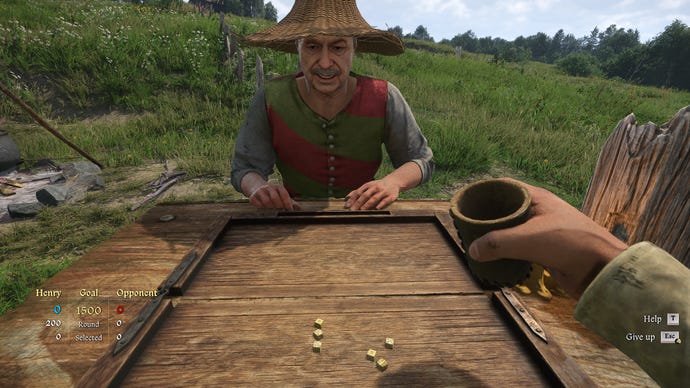Several hours in, it’s become apparent that I lack the patience for much of Kingdom Come: Deliverance 2’s much-publicised historical accuracies, like needing to bathe yourself every six minutes or how 15th century Bohemians can take several consecutive sword swings to the neck without dying. Ah well! If you’re going to play it, know that it’s also a decent performer on PC – despite the almost threatening tone of its recommended system requirements – and, as far as I can see, isn’t anywhere near as bug-prone as the infamously unstable original.
Deliverance 2 has spent the seven-year intermission picking up some new tech tricks as well, most notably DLSS and FSR upscaler support. Head a little deeper into its settings trove, though, and there are still some big performance improvements to be made to be made the old fashioned way.

Kingdom Come: Deliverance 2: system requirements and PC performance
I initially assumed that Deliverance 2’s “recommended” specs had something like tricked-out 4K in mind, as an RTX 4070 and Ryzen 7 7800X3D could coast along at 1080p in their sleep. The minimum specs, while not exactly rock-bottom themselves, are more what you’d expect from a big 3D RPG like this in 2025. Maybe even lower – while 100GB is a big ol’ pile of bytes, there’s no demand that it be specifically dumped on an SSD.
Kingdom Come: Deliverance 2 minimum PC specs
- OS: Windows 10 64-bit
- CPU: Intel Core i5-8400 / AMD Ryzen 5 2600
- RAM: 16GB
- GPU: Nvidia GeForce GTX 1060 (6GB) / AMD Radeon RX 580
- Storage: 100GB available space
Kingdom Come: Deliverance 2 recommended PC specs
- OS: Windows 10 64-bit
- CPU: Intel Core i7-13700K / AMD Ryzen 7 7800X3D
- RAM: 32GB
- GPU: Nvidia GeForce RTX 4070 / AMD Radeon RX 7800 XT
- Storage: 100GB available space
You could probably get away with less than a GTX 1060, in fact. Once I picked a suitably demanding square of Czech forest to benchmark around in, that GPU averaged a comfortable 49fps at 1080p with the Low quality preset, and still managed a playable (if visibly less smooth) 36fps on Medium. Later this week I’ll do a more in-depth Steam Deck guide, but it’s playable on Valve’s handheld as well, typically pulling 30-40fps on Low with FSR on Quality.
In other words, Deliverance 2 is workable on low-end hardware, though how well newer and more mid-range kit will handle it depends heavily on your chosen settings. The most demanding preset, stirringly named “Experimental”, specifically warns you that it’s made for “future”” hardware, and it brought the relatively new RTX 4060 down to just 34fps at native 1080p. Ultra and High quality saw it averaging 52fps and 72fps respectively, so I wouldn’t recommend using the top preset as-is.

See also; the RTX 3070 at 1440p, where even with DLSS on Quality mode, Experimental’ s 44fps was well below Ultra’s 88fps and High’s 88fps in slickness terms. Only the beefiest of graphics cards can do the max-quality business at these higher resolutions: the RTX 4070 Ti hit 65fps at 1440p with Experimental and DLSS Quality, and needed the latter dropped to Balanced mode for 51fps at 4K. True to the game’s word about bleeding-edge hardware, the spanking new RTX 5080 did a lot better, with 70fps at 4K and sticking to DLSS’ Quality mode.
Alright, maybe an RTX 4070 for max-quality 4K is a stretch. But it’s hard to get too mad at Experimental’s demands when the game as a whole runs on GPUs that weren’t even new when the first Deliverance came out, and for what it’s worth, testing on my 16GB RAM-equipped rig presented nothing to suggest that your really, truly need 32GB for higher qualities and resolutions.
It’s also got good ultrawide support, adapting its menus to fully fit the elongated screen, and in what should be a relief to Kingdom Come veterans is Deliverance 2’s (relative) lack of bugs. I know Edwin’s seen a few crashes, and he’s played for quite a bit longer than me, but so far I haven’t experienced a fraction of the game-breakage that the first game suffered from. Here’s the sum total of my witnessed blips: a couple of NPCs briefly out of pose at the start of a cutscene; the lighting effects abruptly changing during the alchemy minigame; and a single staircase that I couldn’t ascend except by sidestepping up it like a medieval crab. That’s it. Maybe don’t take it as a clean bill of health for the considerable stretches of Deliverance 2 I haven’t played, but it does at least appear to have had a more thorough polishing-up than its predecessor.

Kingdom Come: Deliverance 2 settings guide
The odd thing about Experimental graphics is that that, at least when we’re talking presets, they’re not iris-shatteringly more beautiful than Ultra. Especially not in static screenshots, where even I’ll admit you’ll end up playing Spot the Slightly Different Shadow Effect.
And yet, when I went about testing individual settings on my RTX 4060, many of them performed near enough identically on Low as they did on Experimental. Unless you you’re on very, very low-spec hardware, then, you can actually mix up some of the highest settings with just a few Mediums for dramatically boosted framerates. Here’s what I’d suggest:
- Object Quality: Medium
- Global illumination: Medium
- Shadows: Medium
- Vegetation Details: Medium
- Everything else: Experimental
You should also throw in Quality-level DLSS or FSR upscaling at 1440p or above, though DLSS in particular actually looks okay at 1080p. Without it, this settings combination produced a glossy 76fps on the RTX 4060, more than doubling its all-Experimental average of 34fps and landing between its High and Medium preset results. DLSS pushed that all the way up to 105fps, just over triple the original.
Why just those four quality changes? And why Medium rather than Low? Among all the individual settings, these were the only ones that produced more than a 1fps gain when dropped from Experimental to Low. And, also in all four cases, their Medium option was almost as fast: tweaking global illumination, for example, produced 40fps on Low and 39fps at Medium. At these rates, you might as well have the better-looking setting. The biggest difference came from the Shadows setting, where Low produced 53fps by itself and Medium produced 45fps, but the visual difference was also quite stark, and since I was looking at 60fps-plus anyway, I had the headroom to stick with Medium. So will most PCs, I reckon.
That said, feel free to drop Shadows all the way down if your particular PC needs more help. At the bottom of the main graphics menu, there are also easy-to-miss toggles for motion blur and depth-of-field effects; these won’t affect performance either way, but you can disable them entirely if that’s your visual preference.










Add comment